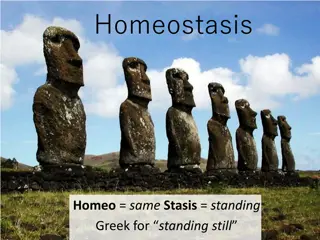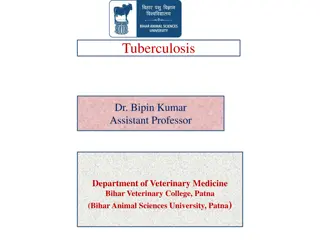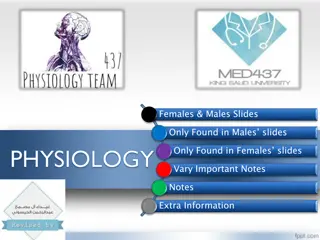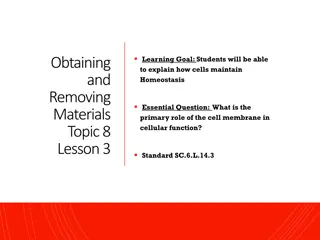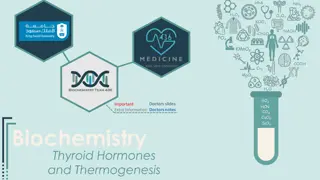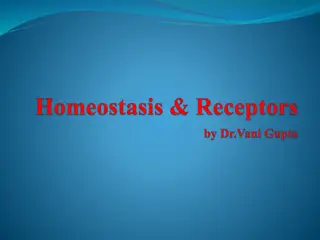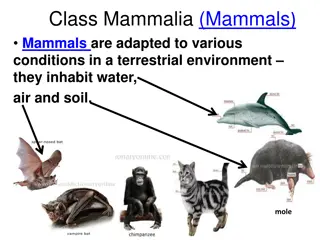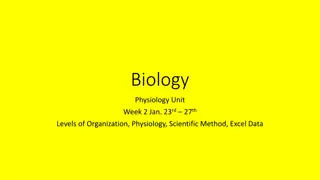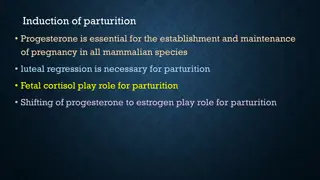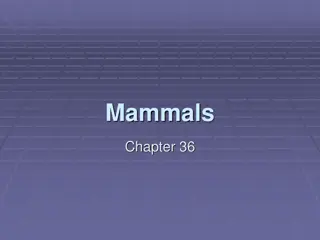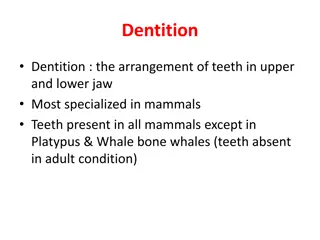Understanding Homeostasis in Humans and Mammals
Humans and mammals rely on homeostasis to maintain a constant internal environment for survival. This involves regulating core body temperature, blood glucose levels, and water levels through nervous and hormonal responses. By understanding the principles of homeostasis, we can appreciate the vital role it plays in our overall well-being.
Download Presentation

Please find below an Image/Link to download the presentation.
The content on the website is provided AS IS for your information and personal use only. It may not be sold, licensed, or shared on other websites without obtaining consent from the author. Download presentation by click this link. If you encounter any issues during the download, it is possible that the publisher has removed the file from their server.
E N D
Presentation Transcript
Click and Teach GCSE BIOLOGY Click and Teach GCSE BIOLOGY TOPIC: HOMEOSTASIS You should have your book (or paper) and a pen
Aims of the lesson Aims of the lesson In order to maintain social distancing and keep everyone safe: (a) You will need to copy from the board, rather than have worksheets (b) Each task increases in difficulty, to cater for all abilities within the classroom (c) Put your hand up if you need some help, but don t leave your seat. (d) Don t share equipment, and keep your work with you at the end of the lesson.
Humans have been able to colonise most of the earth. Even in extreme environments, like the Arctic Circle and the Sahara desert, humans can live and thrive. In spite of this we are actually not very good at surviving in these places if it was not for our technology. Humans, like all mammals need to maintain a constant internal environment. If our core body temperature, blood glucose levels, or water levels change too much we can get very ill or even die. If you recall in the organisation topic, enzymes are very specific. Changes in conditions affect their shape causing them to denature. Enzymes are the main reason for homeostasis. having to consciously think about it. They all follow the same basic structure. Homeostatic control mechanisms come in two forms: Nervous responses: These use nerves to transfer information from the receptors to the brain and spinal cord (co-ordinators) and then to effectors. Hormonal responses: These use hormones which are released from various organs and travel through the blood stream to various effectors. We will look at each in more detail as the topic progresses. To prevent this, our body has a number of systems which it uses to maintain a constant internal environment. Homeostasis is the regulation of the internal conditions of a cell or organism to maintain optimum conditions for function in response to internal (inside e.g sugar consumption, water intake) and external (outside e.g temperature) changes. Homeostatic mechanisms are so important for your survival that they are automatic. This means your body constantly makes adjustments without you
Write the questions TASKS 1. Define homeostasis 2. List 3 things humans, and all mammals, must keep constant to survive. 3. What are two differences between nervous and hormonal responses? 4. Complete the sentences: 5. Mammals need homeostasis because 6. Mammals need homeostasis but .
Answers Self mark Homeostasis is the regulation of the internal conditions of a cell or organism to maintain optimum conditions for function in response to internal and external changes core body temperature, blood glucose levels, or water levels A Nervous system uses nerves, hormonal system uses hormones B Nerves transfer information from receptors to the brain, hormones are released from glands and travel to various organs
What is a receptor? Give an example What is a co-ordinator? Give an example What is an effector? Give an example
Click and Teach GCSE BIOLOGY Click and Teach GCSE BIOLOGY TOPIC: THE NERVOUS SYSTEM You should have your book (or paper) and a pen
Write the questions 1. What is the scientific word for a nerve cell? 2. 3. 4. What kind of signal passes along neurones? What is a synapse? What is the name for the cells which detect changes in the environment? 5. 6. 7. Name the 3 types of neurone in a reflex arc What are the two coordinators of the nervous system? Define effector 8. 9. 10. How is a motor neurone different from a sensory neurone? What type of signal passes through a synapse List 2 ways a neurone is specialised to carry out its function
The nervous system is specifically adapted to react to our surroundings and coordinate our behaviour. The nervous system uses electrical and chemical signals so send information rapidly. Some can even reach speeds of over 100m/s which are as fast as a sports car! The nervous system is made of nerve cells (neurones). Neurones are specialised cells which can carry electrical impulses along their long thin cytoplasm, called an axon. The Axon is surrounded by a myelin sheath which is a fatty layer that insulates the axon Neurones come in 3 main forms sensory neurone, relay neurone and motor neurone. The coordinators for the nervous system are the brain and the spinal cord. These are known collectively as the central nervous system (CNS). The CNS is responsible for coordinating all the sensory information around you, all your thoughts and maintaining all your internal systems (eg heart and breathing rate). Where a nerve ends and joins to another there is a gap. This gap is known as a synapse. At the synapse the electrical signal is transferred into a chemical signal that diffuses across the gap. The synapse is important as it allows the nervous system to direct the signal to the right location. A good analogy is the switches on a railway line that move to ensure a train goes along the right track. Sensory neurone These connect receptors to the coordinator Relay neurones These coordinate the correct response to the stimulus Motor neurone These send the signal from the coordinator to the effector
Self Mark Answers 1. What is the scientific word for a nerve cell? Neurone 2. 3. 4. What kind of signal passes along neurones? Electrical and chemical What is a synapse? Gap between two neurones What is the name for the cells which detect changes in the environment? Receptor cells 5. 6. 7. Name the 3 types of neurone in a reflex arc sensory, motor, relay What are the two coordinators of the nervous system? Brain and spinal cord Define effector a muscle or gland that brings about the response 8. 9. What type of signal passes through a synapse chemical List 2 ways a neurone is specialised to carry out its function long thin cytoplasm to carry impulses over a long distance, surrounded by a myelin sheath which insulates the neurone 10. How is a motor neurone different from a sensory neurone?
The Reflex Arc Reflexes are automatic responses hard-wired into your body. This means the signal never goes to your brain. The relay neurones in the spinal cord coordinate the response and your body will respond without the need for you to think about it. A good example is in the eye. When the light levels are low and it is dark your iris contracts and your pupil gets bigger. If you move into the light, your eyes detect the increase in light and automatically your iris will relax and the pupil will shrink. This happens without conscious thought. Below is a diagram showing the basic structure of a reflex arc. COPY THIS DOWN Another example of a reflex arc is in response to pain. Imagine accidently touching something hot or a pin with your hand. Your body will respond by instantly withdrawing your hand.
1.Complete the table below to show the stages of the reflex arc. The example of the eye has been completed for you Moving from a dark room to a light room Increase in light intensity Light receptors in eye Touching a hot saucepan Stages of reflex arc Stimulus Receptor Neurone that sends signal to coordinator Sensory neurone Relay neurone in spinal cord Coordinator Neurone that sends signal to effector Effector Response Motor Neurone Muscle (Iris) Pupil gets smaller
2. Roger sits on a pin. He screams and jumps up. Describe the journey of the signal through a reflex arc. Make sure you include as much detail as possible. Hint: use the diagram earlier if you are stuck Sentence help; When he sits on the pin . This sends a signal to The __________neurone then . 3. Many human actions are reflexes. Which two of the following are examples of reflex actions? Jumping in the air to catch a ball Raising a hand to protect the eyes in bright light Releasing saliva when food enters the mouth Running away from danger Withdrawing the hand from a sharp object
3. Figure 1 shows how the size of the pupil of the human eye can change by reflex action. Figure 1 a) Name one stimulus that would cause the pupil to change in size from A to B, as shown in Figure 1. b) Structure Q causes the change in size of the pupil. Name structure Q. c) Describe how structure Q causes the change in the size of the pupil from A to B
4. Figure 2 shows some structures involved in the coordination of a reflex action. Describe how the structures shown in Figure 2 help to coordinate a reflex action.
1.Complete the table below to show the stages of the reflex arc. The example of the eye has been completed for you Moving from a dark room to a light room Increase in light intensity Light receptors in eye Touching a hot saucepan Temperature from saucepan Pain receptors in skin Stages of reflex arc Stimulus Receptor Neurone that sends signal to coordinator Sensory neurone Sensory Relay neurone in spinal cord Relay neurone in spinal cord Coordinator Neurone that sends signal to effector Effector Response Motor Neurone Motor Neurone Muscle (Iris) Pupil gets smaller Muscle (bicep) Hand moves away
2. Roger sits on a pin. He screams and jumps up. Describe the journey of the signal through a reflex arc. Make sure you include as much detail as possible. MODEL ANSWER: When he sits on the pin, pain receptors in his skin detect the stimulus, and generates an impulse. This sends a signal to the sensory neurone. The sensory neurone then transmits the impulse to the relay neurones in the spinal cord. The spinal cord co-ordinates a response and sends an impulse via the motor neurones to the effectors. In this case the effectors would be the muscle and the response would be to jump up off of the pin. 3. Many human actions are reflexes. Which two of the following are examples of reflex actions? Releasing saliva when food enters the mouth Withdrawing the hand from a sharp object
3. Figure 1 shows how the size of the pupil of the human eye can change by reflex action. Figure 1 a) Name one stimulus that would cause the pupil to change in size from A to B, as shown in Figure 1. Change in light intensity b) Iris c) A muscle, when contracts, pupil constricts, when relaxes, pupil dilates.
Click and Teach GCSE BIOLOGY Click and Teach GCSE BIOLOGY TOPIC: HUMAN REACTION TIME You should have your book (or paper) and a pen
Aims of the lesson Aims of the lesson In order to maintain social distancing and keep everyone safe: (a) You will need to copy from the board, rather than have worksheets (b) Each task increases in difficulty, to cater for all abilities within the classroom (c) Put your hand up if you need some help, but don t leave your seat. (d) Don t share equipment, and keep your work with you at the end of the lesson.
The time is takes the body to recognise a change and react to it is called the reaction time. The reaction times of human are all slightly different and can be affected by external factors. One of the factors that are thought to improve reaction times is caffeine. Caffeine is found in coffee, fizzy drinks and energy drinks. Below is a method for comparing reaction times. https://www.youtube.com/watch?v=Ws5qVXYHRnQ 1. What was the independent (changed) variable in your investigation? 2. What was the dependent (measured) variable in your investigation? 3. Give two sources of error in the method and one possible way of reducing their impact on the results.
The Nervous System B3 PAG Distance learning write up What is the nervous system made of? (CNS and Peripheral, Sense organs, receptor cells) What is the pathway of a voluntary/conscious response? Hint: starts with stimulus, ends with response How does a reflex action differ from a voluntary action? Which part of the nervous system is omitted? How did listening to loud, heavy metal music affect your ability to react? What was your reaction times with and without the music? Did it increase or decrease it? Draw a bar graph to show these results X axis with and without music Y axis reaction time (s)





